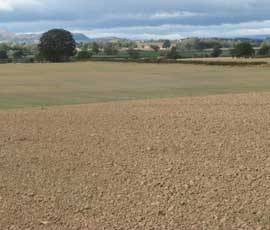Review 2011: A year of weather extremes

With 2011 coming to an end, Farmers Weekly looks back at some of the events that shaped this year, like the way extreme weather has affected farmers across the UK.
The weather extremes of 2011 cost British farmers hundreds of millions of pounds in lost crops, poor yields and structural damage.
In central, southern and eastern England, farmers are still counting the cost of drought. Earlier in the year analysts predicted that the financial impact of the dry weather could be as much as £400m.
By contrast, Scottish farmers will remember 2011 for the persistent wet conditions that plagued harvest and delayed combining.
But it was the aftermath of freezing conditions that marked the start of the year. Sugar beet growers suffered losses of £52m as plants rotted and factories rejected crops that could not be processed.
Despite the exceptionally cold December, the winter was slightly milder than last year, according to Met Office figures. The mean UK winter temperature was 2.4degC compared with 1.6degC in winter 2010.
The ninth-warmest February on record gave rise to an extremely dry spring in most regions. It was the warmest April on record, with many places seeing temperatures 3-5degC warmer than normal, with a record average UK temperature of 10.7degC.
The warm weather was also accompanied by mainly dry conditions through the month, and the UK average rainfall total was 36.7mm – just 52% of the long-term average.
The drought continued through the summer for central, south and east regions.
But Scotland was hit by heavy rainfall in August. Constant showers caused farmers huge frustration and made it a stop-start harvest.
September and October were a lot warmer than average, with a combined mean temperature of 14degC in central England.
Last November, the central England average was a chilly 5.1degC, but this year the average was 9.7degC – 2.8degC above the long-term mean, making it the second-warmest since 1659.
Earlier this month, Scotland was battered with storm-force gales of up to 165mph. Elsewhere, the weather has been unsettled.
Case study one: ‘Driest ever spring’
Andrew Pendry, farm manager for Burden Brothers, on the Isle of Sheppey, Kent.
Andrew Pendry blamed a lack of moisture after spring wheat yields fell to an average of 4.1t/ha this year.
“From the end of February when we drilled it until mid-May we had no rain at all. It was our driest spring ever,” he said.
Considering the dry conditions, oilseed rape crops fared remarkably well, yielding 4.64t/ha on average, compared with a farm average of 3.3t/ha.
His grain maize also thrived in the “tropical conditions”, yielding 10.1t/ha on average, when it would usually yield 8-9t/ha.
But a dry autumn, with just 28mm of rainfall in September and October, caused him a drilling nightmare.
“Autumn oilseed rape establishment has been very difficult.”
This year, Mr Pendry took on a second farm in Tunbridge Wells, which had 87mm of rainfall in September and October. “Everything drilled really well there. Crops have all come up and they look great.”
Case study two: ‘Soggy – the worst I have ever known’
Adrian Ivory, farm owner, Strathisla Farms, Perthshire.
“Soggy” sums up the year for Adrian Ivory, who recorded 100mm of rain for five consecutive months from May to September.
As a result, he finished combining on 28 September, two weeks later than usual, and crop yields were down across the board.
Winter barley crops yielded 7.4t/ha, compared with the farm average of 6.9t/ha; winter wheat yielded 7.2t/ha (>8.0t/ha), and spring barley yielded 5.4t/ha (>6.2t/ha).
“Yields were down, but thankfully prices were good,” said Mr Ivory, Farmers Weekly Farmer of the Year for 2008.
Keeping the water ice-free was a struggle over the winter for the farm’s 235 cows. Then it rained so much in the autumn that the ground was too saturated to stand the cattle.
They were brought inside, but because October was so warm, pneumonia was a major issue.
“Cattle production was not too bad and prices were good. Overall, the weather was dire – it’s the worst I’ve known.”
Five weather facts for 2011 (*courtesy of the Met Office)
· 9.15degC was the average temperature in spring in the UK, the warmest since records began in 1910
· 11.24degC was the average temperature in autumn in the UK, the second warmest on record
· England had an average spring rainfall of 79.2mm, the second driest on record
· Scotland had an average spring rainfall of 376mm, the eight wettest on record
· A record high temperature for October of 29.9C was set in Gravesend, Kent on 1 October
Click here for a map showing the 2011 UK rainfall.

